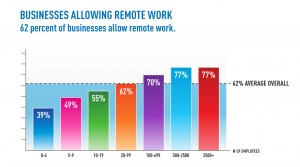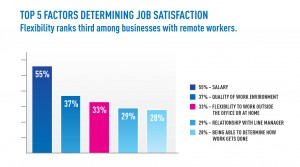Working from home is becoming more popular according to a report from Skype. And as Mashable mentions in their post about the report:
As someone who regularly works from home, I find this trend hardly surprising. But it’s not just bloggers, start-up types and technophiles who are making pajamas the new “business casual.” Even seasoned executive types (like my own father, for example) are logging in remotely these days.
The proliferation of online collaboration tools is one indicator that “WFH” (that’s short for “working from home,” my dad tells me) culture is blossoming. In fact, Skype and tools like it have pretty much made the necessity of a 9-to-5 physical presence behind a cubicle-bound desk obsolete.
With the proliferation of working from home entering the corporate conscience, it pays to really think about it from all angles before jumping in with both feet.
Working at home: The Good
I’ve worked from home exclusively for two and a half of the last four years. The last six years, I’ve had the ability to work from home at least occasionally.
Almost all of my professional career has been in the realm of location flexibility for the work I do. It is worth mentioning that working at home full time is a completely different animal than occasionally taking your laptop home for the day. I’ll try to address both as we work through them all.
 The temporary productivity boost from taking work home can be a real benefit. Offices are full of distractions, meetings, and unplanned time away.
The temporary productivity boost from taking work home can be a real benefit. Offices are full of distractions, meetings, and unplanned time away.
For example, whenever I had a bunch of resumes to go through for a job opening, I would take it home to sort and do my initial calls with candidates. With interruptions at the office, it could take 50-100 percent longer. Hiring was a critical task that couldn’t be put off so prioritizing it meant taking it home.
Similarly, working from home full time offers an environment constantly free of major distractions. Even the little distractions like the telephone and instant messaging can be muted (albiet temporarily) to get through tasks. In addition, working from home affords the opportunity to work when I am most efficient and lets me easily monitor our social profiles and communities, even at odd times of day. And that’s on top of the auxiliary benefits like having no commute, reduced work apparel costs, and eating much better.
For HR and recruiting professionals, offering one or both can be seen as a big benefit. According to the report from Skype, 33 percent of employees at companies with remote workers rank working from home as a major factor in their job satisfaction (trailing only salary and work environment).
Working at Home: The Bad
The worst thing that can happen in a situation where you allow some work at home part time is the potential for abuse. I know big time flexible work advocates like to downplay this fact, but it is a reality for some.
Of course this isn’t a reason to not have it but it is something to closely monitor, especially when you’re rolling it out. While employees may feel like they are getting more done, there are some who may not be getting the same throughput as before. Managers need to be comfortable going into these discussions and be prepared to pull flexibility individually if it is problematic.
 For permanent work at home folks, it feels like abuse is less of an issue. After all, you have to produce at some point and if you have a manager that monitors it, it is pretty easy to pick out. But working from home full time requires a more cognizant effort. While there are less people distractions, there are other, more subtle distractions.
For permanent work at home folks, it feels like abuse is less of an issue. After all, you have to produce at some point and if you have a manager that monitors it, it is pretty easy to pick out. But working from home full time requires a more cognizant effort. While there are less people distractions, there are other, more subtle distractions.
For example, I have a hard time working in a really messy space. When I had an office, it took a few minutes to organize ,but when you’re at home, it could take much longer. Even just figuring out a rhythm of the day without a commute and location change can take some time. And ultimately, some just may prefer to work out of an office — which is going to keep some people from enjoying an otherwise great job.
Working from Home: The Ugly
The unspoken issues about working from home full time are deeper than those who work from home part time. Working from home part of the time doesn’t take a major culture shift. Sure some will be uncomfortable with it at first but once it is accustomed, it feels like a natural part of work.
Working from home full time is different because it changes the culture of the workplace. There are many things I don’t miss about working in an office, but the one thing I do miss is daily, face-to-face interaction.
For those of us in full work from home state, there are some solutions. I’ll often work out of a coffee shop for part of a day or two just for a change of pace. For people in metro areas, there are co-working spaces that are great, and as The Miami Herald mentions, are quickly expanding:
Collegial in spirit and form, the spaces offer offices, desks and shared tables at a fraction of traditional office costs and with reliable WiFi. Floor plans are typically open, offices have glass walls, and lounges have a decidedly student center vibe. Instead of signing leases, tenants become members.
Just five months since opening in Midtown, Buro Miami has already filled its 11,000 square feet with 47 companies and is pondering expansion. Across from the American Airlines Arena, MiamiShared has 80 members in 8,000 square feet and will merge this month with Brikolodge, Miami’s first coworking space. In Fort Lauderdale, the White Table Foundation has maxed out its 1,200 square feet on downtown Las Olas Boulevard.
I’ve tried out co-working space in Portland for a day and while it is nice, I still prefer my home base for most days.
The option to interact with people in similar work situations without fighting for a table at a coffee shop is still an attractive option on the days that I feel I want some face-to-face interaction. It can all be part of the way to put more of the good and take out the bad and ugly from working at home.
